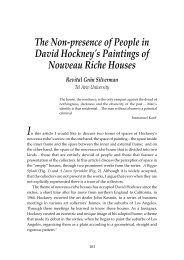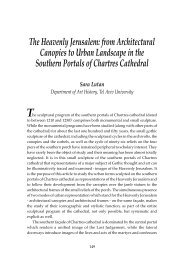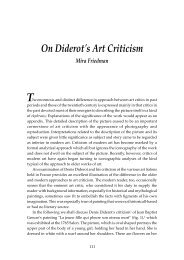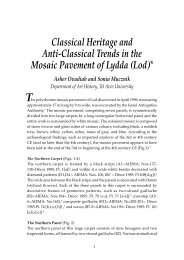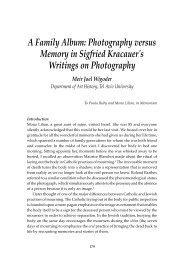The Temple in the Iconography of Early Christian Art Carla Gomez ...
The Temple in the Iconography of Early Christian Art Carla Gomez ...
The Temple in the Iconography of Early Christian Art Carla Gomez ...
You also want an ePaper? Increase the reach of your titles
YUMPU automatically turns print PDFs into web optimized ePapers that Google loves.
y only one scholar. <strong>The</strong> work <strong>in</strong> question is <strong>the</strong> Annunciation on <strong>the</strong> triumphal<br />
arch <strong>of</strong> Santa Maria Maggiore. Pietro Toesca notes that this section <strong>of</strong> <strong>the</strong> mosaic<br />
follows <strong>the</strong> Proto-Gospel <strong>of</strong> James and depicts <strong>the</strong> Virg<strong>in</strong> Mary sitt<strong>in</strong>g by <strong>the</strong><br />
<strong>Temple</strong>, <strong>in</strong> which <strong>the</strong> angels have fed her s<strong>in</strong>ce her childhood. 61 All o<strong>the</strong>r<br />
scholars ma<strong>in</strong>ta<strong>in</strong> that she is sitt<strong>in</strong>g by her own house, some add<strong>in</strong>g that it has<br />
<strong>the</strong> form <strong>of</strong> a temple just as Joseph's does <strong>in</strong> <strong>the</strong> parallel scene. 62 Leclercq, without<br />
referr<strong>in</strong>g at all to <strong>the</strong> build<strong>in</strong>g, also states that <strong>the</strong> scene is taken from <strong>the</strong> Proto-<br />
Gospel <strong>of</strong> James but identifies it as Mary sp<strong>in</strong>n<strong>in</strong>g <strong>the</strong> purple thread that will<br />
be used to weave <strong>the</strong> curta<strong>in</strong> screen<strong>in</strong>g <strong>the</strong> Holy <strong>of</strong> Holies <strong>in</strong> <strong>the</strong> <strong>Temple</strong>. 63<br />
However, nowhere <strong>in</strong> this Proto-gospel is it said that Mary receives <strong>the</strong><br />
Annunciation sitt<strong>in</strong>g by <strong>the</strong> <strong>Temple</strong>, thus mak<strong>in</strong>g Toesca's attribution<br />
<strong>in</strong>explicable. It would seem, <strong>the</strong>refore, that this structure should not be<br />
numbered among depictions <strong>of</strong> <strong>the</strong> <strong>Temple</strong>.<br />
Conclusions<br />
Any exam<strong>in</strong>ation <strong>of</strong> <strong>the</strong> depictions <strong>of</strong> <strong>the</strong> <strong>Temple</strong>, as clearly shown <strong>in</strong> this article,<br />
must <strong>in</strong>evitably lead to <strong>the</strong> conclusion that no uniform tradition exists for such<br />
depiction. In <strong>the</strong> majority <strong>of</strong> <strong>in</strong>stances <strong>the</strong> <strong>Temple</strong> is merely <strong>in</strong>dicated by means<br />
<strong>of</strong> one or ano<strong>the</strong>r architectural elements and only <strong>the</strong> context permits its positive<br />
identification. Even when a complete build<strong>in</strong>g is depicted, its structure is far<br />
from observ<strong>in</strong>g <strong>the</strong> historical facts. <strong>The</strong> <strong>Temple</strong>, as presented <strong>in</strong> <strong>Early</strong> <strong>Christian</strong><br />
art, was based, <strong>in</strong> most <strong>in</strong>stances, on pagan edifices. <strong>The</strong>re were many such<br />
examples still stand<strong>in</strong>g and <strong>the</strong>y appeared <strong>in</strong> various works <strong>of</strong> art. <strong>The</strong> general<br />
form was a square structure built <strong>of</strong> hewn stone, with a pediment and slop<strong>in</strong>g<br />
tiled ro<strong>of</strong>, and a façade with two or four columns. This basic model might be<br />
supplemented with o<strong>the</strong>r details such as curta<strong>in</strong>s or a lamp hang<strong>in</strong>g at its<br />
entrance or a flight <strong>of</strong> steps lead<strong>in</strong>g up to <strong>the</strong> build<strong>in</strong>g. Even when <strong>the</strong> <strong>Temple</strong><br />
is depicted more than once <strong>in</strong> <strong>the</strong> same work or <strong>the</strong> same build<strong>in</strong>g, each<br />
representation is different, such as <strong>in</strong> Sant' Apoll<strong>in</strong>are Nuovo. Fur<strong>the</strong>rmore,<br />
<strong>the</strong> architectural elements used to depict <strong>the</strong> Jerusalem <strong>Temple</strong> are not exclusive<br />
but also figure <strong>in</strong> o<strong>the</strong>r scenes connected to <strong>the</strong> life <strong>of</strong> Jesus.<br />
In <strong>the</strong> majority <strong>of</strong> <strong>the</strong> works <strong>of</strong> art, it is <strong>the</strong> <strong>Temple</strong> exterior that is depicted.<br />
Only two works also attempt to portray its <strong>in</strong>terior - <strong>the</strong> mosaic <strong>in</strong> <strong>the</strong> <strong>The</strong>otokos<br />
Chapel on Mount Nevo and <strong>the</strong> Northumbrian casket. Despite <strong>the</strong> geographical<br />
distance between <strong>the</strong>se two places, <strong>the</strong> basic conception and even <strong>the</strong> form <strong>of</strong><br />
representation is similar. Did a common model serve <strong>the</strong>m both? We have no<br />
clear answer to this question.<br />
<strong>The</strong> earliest work mentioned here is <strong>the</strong> early fourth century (335 C.E.)<br />
wooden l<strong>in</strong>tel from Egypt (fig. 4) but <strong>the</strong> identification <strong>of</strong> <strong>the</strong> dome depicted<br />
76


